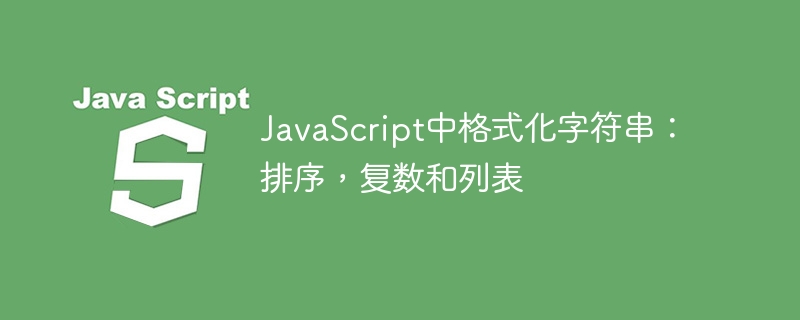JavaScript中格式化字符串:排序,复数和列表
时间:2025-02-10 09:34:11 377浏览 收藏
学习知识要善于思考,思考,再思考!今天golang学习网小编就给大家带来《JavaScript中格式化字符串:排序,复数和列表》,以下内容主要包含等知识点,如果你正在学习或准备学习文章,就都不要错过本文啦~让我们一起来看看吧,能帮助到你就更好了!

您是否曾尝试对不同语言的单词进行排序、处理复杂的复数规则或以自然的方式格式化列表?Intl API提供了一些强大的功能,尤其是在处理字符串和列表方面。
简述
我们将重点介绍三个强大且常被忽视的功能:
Intl.Collator:正确排序和比较字符串,支持多种语言。Intl.PluralRules:处理多种语言的复数形式。Intl.ListFormat:以自然的方式格式化列表,适应不同语言的习惯。
Intl.Collator
字符串排序并非易事。不同的语言对字母顺序、大小写敏感性和变音符号有不同的规则。Intl.Collator应运而生!
基本排序
const listFormatterFr = new Intl.ListFormat("fr", {
style: "long",
type: "conjunction",
});
console.log(listFormatterFr.format(["pomme", "banane", "cerise"]));
// "pomme, banane et cerise" (法语使用 "et" 代替 "and")
const shortFormatter = new Intl.ListFormat("en", {
style: "short",
type: "disjunction",
});
console.log(shortFormatter.format(["tea", "coffee", "milk"]));
// "tea, coffee, or milk" (disjunction 使用 "or" 代替 "and")
选项
type:'conjunction'("and")、'disjunction'("or")或 'unit'(例如,“5 小时,30 分钟”)。style:'long'(默认,完整单词)、'short'(缩写)、'narrow'(最小格式)。
结论
Intl.Collator、Intl.PluralRules 和 Intl.ListFormat 可以帮助您的 JavaScript 应用程序更国际化、更友好!这些 API 可以为您节省大量工作,并帮助您的应用程序轻松支持多种语言。
您之前尝试过这些 Intl 功能吗?
以上就是《JavaScript中格式化字符串:排序,复数和列表》的详细内容,更多关于的资料请关注golang学习网公众号!
相关阅读
更多>
-
502 收藏
-
501 收藏
-
501 收藏
-
501 收藏
-
501 收藏
最新阅读
更多>
-
147 收藏
-
491 收藏
-
109 收藏
-
366 收藏
-
392 收藏
-
356 收藏
-
383 收藏
-
105 收藏
-
127 收藏
-
369 收藏
-
419 收藏
-
192 收藏
课程推荐
更多>
-

- 前端进阶之JavaScript设计模式
- 设计模式是开发人员在软件开发过程中面临一般问题时的解决方案,代表了最佳的实践。本课程的主打内容包括JS常见设计模式以及具体应用场景,打造一站式知识长龙服务,适合有JS基础的同学学习。
- 立即学习 543次学习
-

- GO语言核心编程课程
- 本课程采用真实案例,全面具体可落地,从理论到实践,一步一步将GO核心编程技术、编程思想、底层实现融会贯通,使学习者贴近时代脉搏,做IT互联网时代的弄潮儿。
- 立即学习 516次学习
-

- 简单聊聊mysql8与网络通信
- 如有问题加微信:Le-studyg;在课程中,我们将首先介绍MySQL8的新特性,包括性能优化、安全增强、新数据类型等,帮助学生快速熟悉MySQL8的最新功能。接着,我们将深入解析MySQL的网络通信机制,包括协议、连接管理、数据传输等,让
- 立即学习 500次学习
-

- JavaScript正则表达式基础与实战
- 在任何一门编程语言中,正则表达式,都是一项重要的知识,它提供了高效的字符串匹配与捕获机制,可以极大的简化程序设计。
- 立即学习 487次学习
-

- 从零制作响应式网站—Grid布局
- 本系列教程将展示从零制作一个假想的网络科技公司官网,分为导航,轮播,关于我们,成功案例,服务流程,团队介绍,数据部分,公司动态,底部信息等内容区块。网站整体采用CSSGrid布局,支持响应式,有流畅过渡和展现动画。
- 立即学习 485次学习
